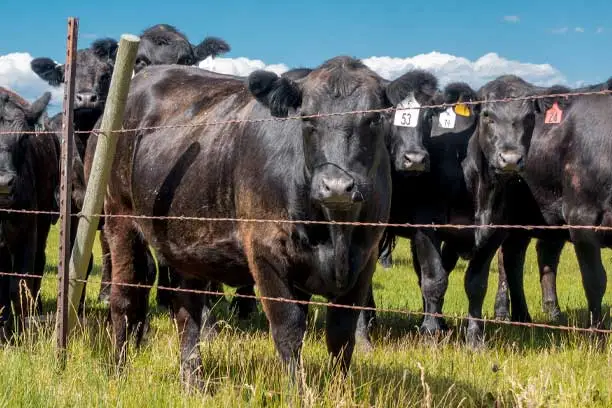7 Ways to Protect Livestock From Predators


Your livestock are a crucial part of your agriculture business. But to cattle predators, they represent something entirely different: a meal.
That means protecting your livestock from coyotes, for example, is vitally important to the health of your business. If you’re trying to protect your livestock from predators, here are seven tips you can use to protect your investment and keep them safe.
Guardian animals live with and protect livestock from predators. But guardian animals — most commonly dogs, llamas and donkeys — don’t just keep your livestock safe; they can also help relieve stress felt by your herd. Less-stressed animals typically gain more weight, so while you’re protecting the animals you’re also increasing your bottom line and overall health of your animals.
The ideal guardian animal for your herd depends on your livestock, your layout and the farm predators that you’re protecting against, so consult a professional as you’re weighing your options. Don’t forget: non-guardian animals can also help protect your livestock in indirect ways. Barn cats, for example, keep rodent populations low, which protects eggs that the rodents might otherwise eat. Roosters help alert you to danger in your chicken coop. Do some research for your specific needs to ensure the guardians you decide on will work well with your livestock.
When you are ready to introduce guardian animals to your herd, start them young and raise them with the herd they will protect. While livestock guard dogs are the most common guardian animals, they often follow the working and sleeping schedule of the main house. Llamas and donkeys, on the other hand, live with the livestock at all times, and their keen senses and aggressive nature toward intruders make them excellent full-time protection from predators.
But do not put donkey defenders in the same herd with dogs. Donkeys don’t like dogs, which in turn makes them naturally aggressive against coyotes and wolves.
If you have multiple types of grazing animals, such as goats and cows, let them graze together. The cows’ size can be a deterrent to predators that might otherwise be tempted to target the smaller goats. Herd animals have a natural tendency to “bunch.” This defense mechanism is how cows and goats protect themselves from predators, which prefer a moving target to animals that stand their ground.
You might be tempted to use predator-proof fencing. But the reality is that keeping your livestock safe in areas that have predator-proof fencing is incredibly difficult. Many predators — such as coyotes — can squeeze through small gaps or go over fences. Furthermore, birds of prey attack from above, making it extra difficult to protect the animals they hunt.
However, there are alternative fencing methods that may help protect your livestock. Consider mesh wire electric fencing, which typically requires less maintenance and provides a better barrier than single or multi-strand electric fencing. Living fences, often constructed from trees such as willow, provide a solid barrier to predators; they’re also windbreaks, and they prevent soil erosion. To deter birds of prey from getting to your chickens, create a web of fishing line over the top of the coop and hang reflectors (such as old CDs) to startle predators. Also consider motion-activated lights and alarms around the edges of your property to help scare away ground predators.
It may not seem obvious at first but making calculated changes to the way you run your agriculture business can help protect your livestock. For example, the smell of pigs reminds predators of wild boar and can scare them away. So, consider moving your pig pens to the edge of your property as a first line of defense. Changing up your grazing schedule or moving livestock to new areas can also throw predators off, keeping your animals safe.
Most predators are nocturnal. That means having a safe, secure location for your animals at night is critical in protecting them. This can be especially helpful if your animals roam a large area during the day that makes predator-proof fencing too costly or difficult to install. Bringing your goats, sheep and cows to an area that has electrified fencing at night can help protect them when they are most at risk (and when you’re not awake to potentially keep an eye on things). Young and weak animals are prime targets of predators, so keep these animals close to the house or in a building when possible.
If you’ve experienced an attack, move your livestock and keep them safely locked up for a few days after the attack. The predator may move on after a series of unsuccessful hunts. If you can, find and block entry points predators are using to get onto your farm or ranch. For example, repair any holes in the fencing (coyotes can squeeze into a hole that’s just 4x6 inches!), which will stave off predators that now have to locate a new way to reach your livestock.
If there is an abundance of wild game in your area, predators are less likely to prey on your livestock. The wild game acts like a decoy, and it’s much lower-hanging fruit for the predator than your protected herd. You can help maintain a healthy prey population by creating an area away from your livestock that is great for animals like wild game and rabbits to live in. You can plant food plants, encourage grass to grow tall and create brush piles. If a predator can feed itself and its young without coming onto your farm or ranch, it will likely do that. The ultimate goal is to make predators think eating your animals is so difficult that it’s not worth it, steering them toward wild game, rabbits and rodents instead.
Your agriculture business revolves around making the best decisions about protection that you possibly can. Is your whole farm or ranch protected? Talk to a Farm Bureau agent today.